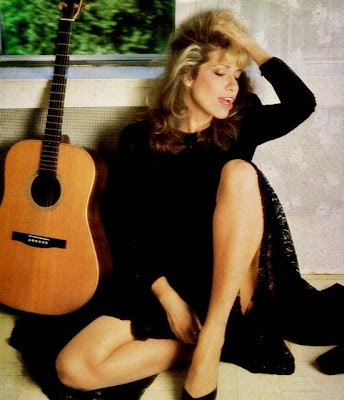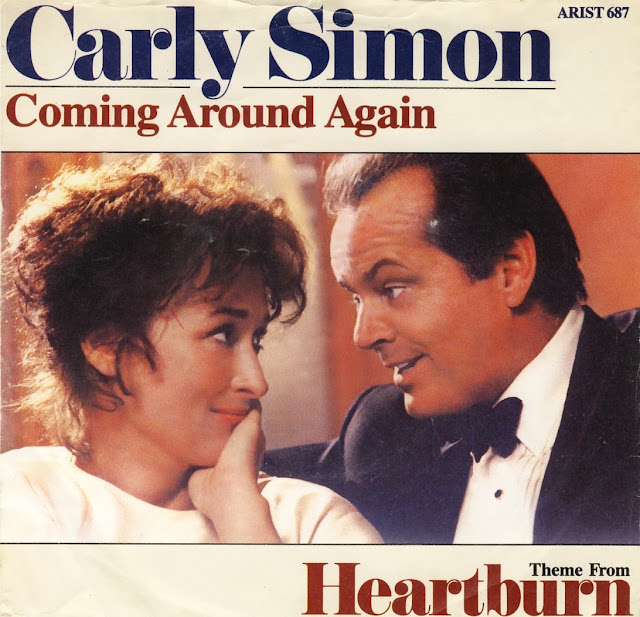In pop music terms, six years is an eternity. Within that time, a new generation of young fans discover and establish their tastes, and the previous generation turns to listen to the oldies station, or their baby monitors, or their boss' incessant demands. Indeed, musical fashions can come and go in half that time, and a star's career can rise, peak, trail away and disappear altogether. The six years after the success of "Jesse" in 1980 therefore seemed interminable, as none of Carly's new releases scored well on the American charts. By 1986 it appeared as though she was moving - perhaps irreversibly - out of the mainstream of pop music. It was easy to imagine that, like her contemporaries - Carole King, Joni Mitchell, Roberta Flack - she would increasingly be regarded as a Seventies legend rather than a contemporary, high-profile artist.
Then, in the summer of that year, the song "Coming Around Again" arrived. It was the theme to the Mike Nichols-Nora Ephron film Heartburn, for which Carly had written the score. Arista Records, her new label, was none too quick at promoting the song. The film was released in July and the single (see the picture sleeve at the bottom of this page) was not released until September. Yet once radio stations got hold of it, they were reluctant to let go. By November, it had become a genuine, bona fide, now-playing-everywhere hit single. This was no small feat for a song that tells a story involving a sneezing baby, a broken toaster and a burnt soufflé. "Coming Around Again" is almost operatic in its melodrama and its maturity, taking the listener from the bluesy, wistful chorus of So don't mind if I fall apart/there's more room in a broken heart, to an open-hearted ending in which the singer affirms I do believe/I do believe/I believe in love/And it's coming around again. It was unmistakably a new Carly classic, and the compelling details of the lyrics and the instantly hummable melody placed it among her finest songs.
The Coming Around Again album arrived in April 1987, and its cover was nothing short of triumphant. In this context, the title had a meaning beyond the song itself. It spoke of her career resurgence, and setting the lettering within a green banner also evoked her evergreen status as a musician. The photograph, a close head and shoulders portrait by Lynn Goldsmith, spoke volumes about her new confidence and the upbeat tone to the new songs. Not since Hotcakes, thirteen years earlier, had she looked directly into the camera while flashing that trademark, toothy smile. The smile, her full lips, and her tousled hair combined to form an immediately recognizable portrait. The celebratory tone was also conveyed by placing only her first name on the cover. The size of the lettering makes a statement: this is a name as recognisable as Madonna or Cher. Yet the warm simplicity of the photo, and the pale pink color scheme, simultaneously conveys that the new, call-me-Carly, first-name basis is grounded in affection and familiarity. This is not a declaration of high-diva status, but simply the return of an old friend.
From a marketing standpoint, the cover was sheer genius: it served as a projection of the public's affection for her while also signalling the more hopeful, romantic tone of her new songs. Her previous album, Spoiled Girl, had been dominated by the concept of romance as a competition, but on Coming Around Again a calmer, warmer and more mature perspective prevails. In "Give Me all Night", the lyrics The pain of love, I'll accept it all/As long as you'll join me in that emotion, celebrate every aspect of love, and suggest that even the low points are worth going through if they are shared. The gospel-tinged "The Stuff That Dreams Are Made Of", the story song "Two Hot Girls (on a Hot Summer Night)", and the smooth groove of "All I Want is You" also combine her characteristically impassioned vocals with a wise and emotionally centered outlook. "Do the Walls Come Down" continues in this vein, too, and it is the album's show stopper. In this hushed ballad, she ponders whether a past lover occasionally lowers his guard and allows himself to remember his feelings for her, or whether those feelings are carefully and determinedly kept at bay. The lyrics Is it easier for you to say/You never loved me anyway/Or do you hide me in your attic trunk/Like a stowaway, are sung with a clear-eyed resignation that strikes a perfect balance between the bitter and the sweet.
If the album's music represents a return to her highest form, it must be said that its cover has little of the artistry or edginess of her previous albums. Indeed, it could be said that it has all the imagination of the annual student photographs taken in elementary school. Remember, back at school, waiting in line to be placed in front of an obviously artificial backdrop, told to smile as the shutter clicked, and then quickly moved on? The cover of Coming Around Again has a similar quick and cheerful, no-frills quality. That, however, was the point: to offer a vision of Carly as up front, uncomplicated, accessible and agreeable.
 Not surprisingly, the cover shot was the choice of the record company rather than Carly herself. She preferred the more stylish and intriguing photograph (on the left) that was ultimately used on the back cover of the album. This was another shot taken by Goldsmith, and it is a winner. The guitar evokes her past acoustic hits and her musicianship. The slip of the dress casually reveals those famously long, long legs. Her position on the floor is characteristically quirky, and so too is her facial expression, which suggests that we have caught her unaware and in mid-song. And, even though the setting is actually her Manhattan apartment, the window looking out on to the thick foliage of Central Park West lends an earthy, bohemian air to this portrait. In all of these respects, it is quite unlike the studio portrait of the cover shot, and in aesthetic terms at least it is far more interesting than the cover.
Not surprisingly, the cover shot was the choice of the record company rather than Carly herself. She preferred the more stylish and intriguing photograph (on the left) that was ultimately used on the back cover of the album. This was another shot taken by Goldsmith, and it is a winner. The guitar evokes her past acoustic hits and her musicianship. The slip of the dress casually reveals those famously long, long legs. Her position on the floor is characteristically quirky, and so too is her facial expression, which suggests that we have caught her unaware and in mid-song. And, even though the setting is actually her Manhattan apartment, the window looking out on to the thick foliage of Central Park West lends an earthy, bohemian air to this portrait. In all of these respects, it is quite unlike the studio portrait of the cover shot, and in aesthetic terms at least it is far more interesting than the cover.
But one should not argue with success. Clive Davis, the Arista supremo who served as executive producer of Coming Around Again, oversaw just about every step of this project. By some accounts, this was an unhappy process at times, and the album's commercially oriented qualities are clearly attributable to him. For example, a forced collaboration between Carly and Bryan Adams, on Adams' "It Should Have Been Me", is a marketing man's dream, but it is also remarkably bland by comparison with her own songs. Nevertheless, Davis had a good ear for what would work on the radio, and the album spawned a host of radio hits. He also had a good eye for a cover that would entice new and old fans alike. Coming Around Again went gold, and then platinum, and even today it continues to be one of her bestselling catalogue albums. Its success represented a career renewal and extension into the next decade and beyond. If it was not her best album cover, it certainly helped to ensure that there were many more albums to come.


i really enjoy your thought provoking insight into the album world of carly - brilliant!
ReplyDeleteLove your thoughtful analysis of this (and other albums). You do Carly Simon proud!
ReplyDeleteThis record was my entry point to Carly Simon as an albums artist and I was pretty much hooked straightaway. In those pre-internet days of the late 80s/early 90s, it was long but interesting process to learn about and then find her earlier works (Simon being slightly less well-known in the UK than the US) Lots of skimming through record bins and music encylopedias in bookshops ensued!
ReplyDeleteI never registered the significance of the single "Carly" on the cover OR the double meaning of the album's title before now. Great blog, well done! (And I'd love it if you added some more entries too!)
This comment has been removed by the author.
ReplyDelete